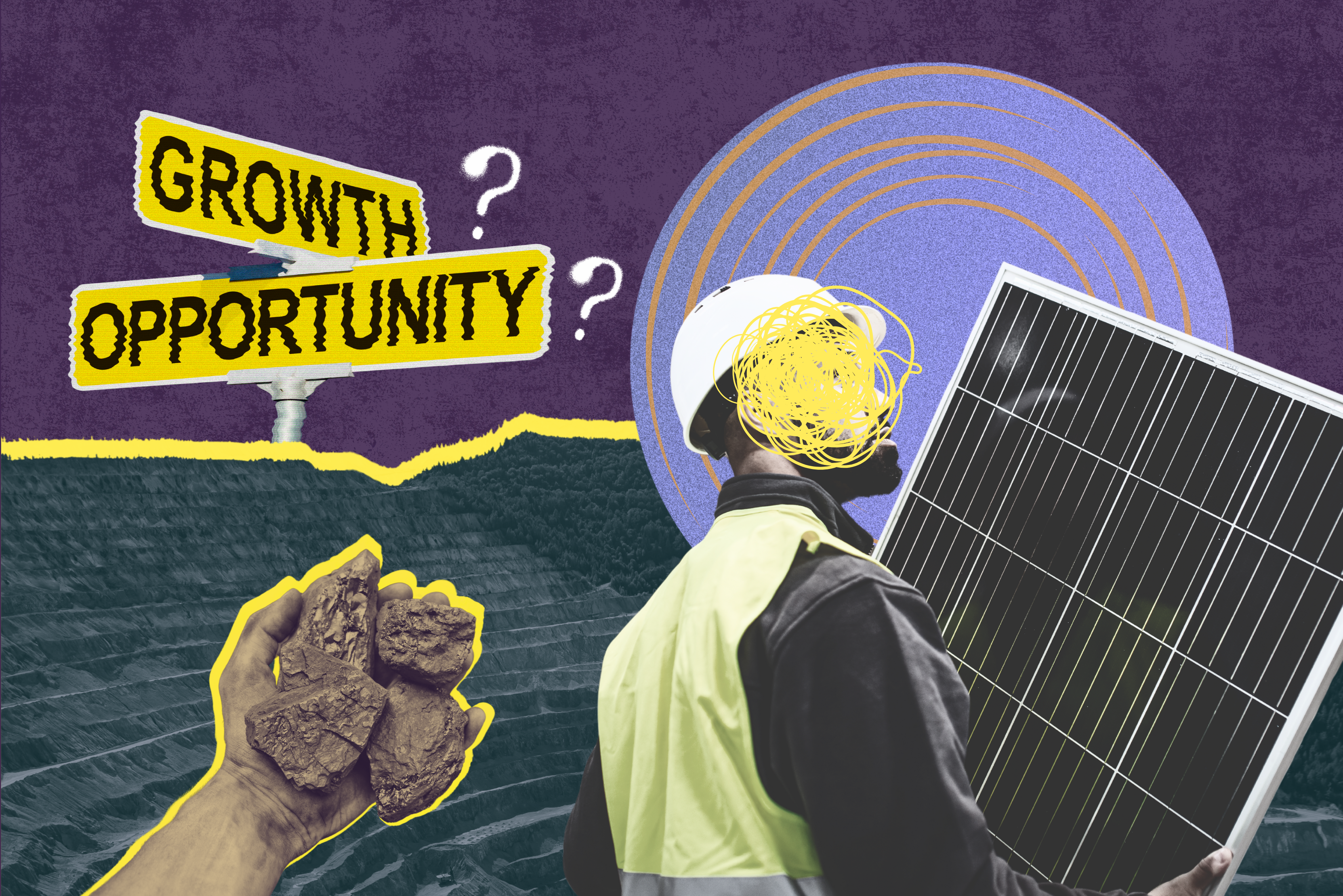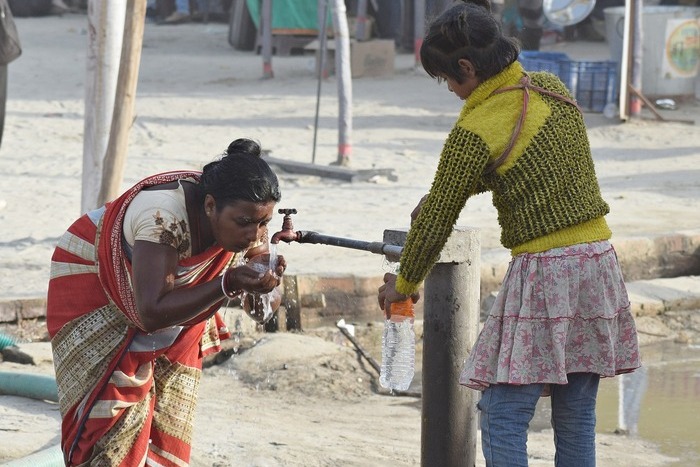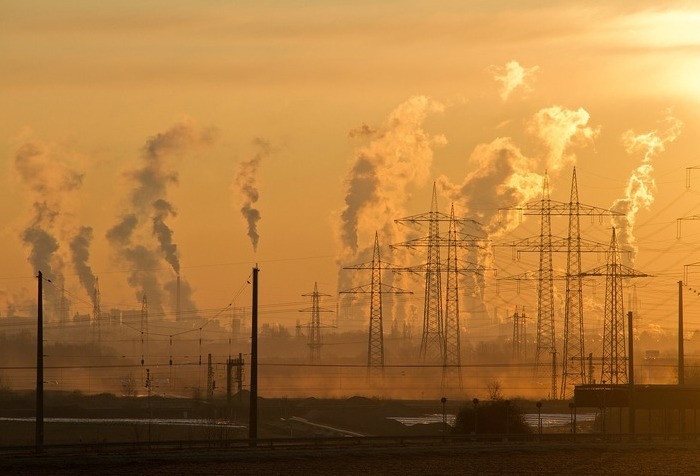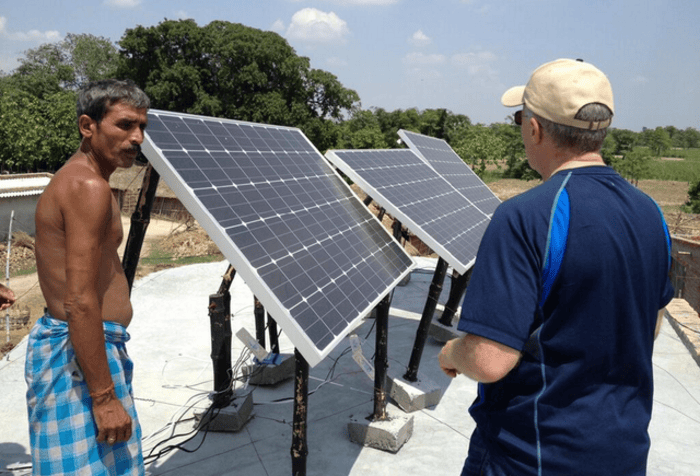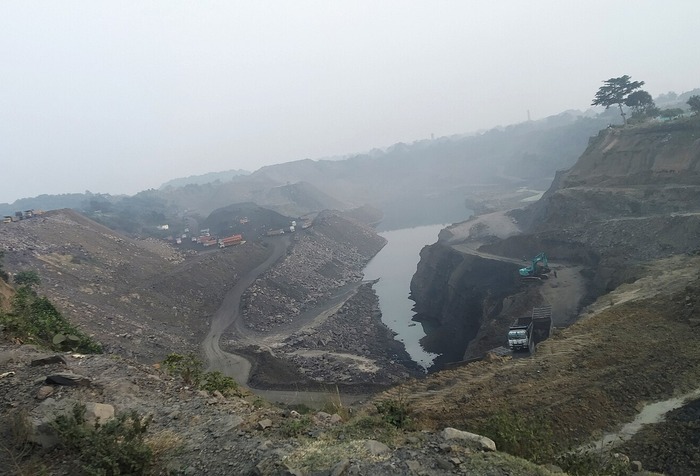
Creative: Riddhi Tandon
India’s coal heartland is powering down, with no safety net
The energy shift is redrawing India’s economic map, but for coal belt workers in states like Jharkhand, the just transition is already collapsing under policy inaction
Even after three decades, the village of Manki in Jharkhand’s Chatra district still bears the marks of abandonment with its old houses and rusted electric poles. It was home to workers from a now-abandoned coal mine nearby. Today, the mine is buried under wild shrubs and red-flowering trees, with little evidence left of the 300-strong workforce it once employed.
Manki presages the future. Long before “just transition” became a global talking point, the village had already borne the brunt of its absence. Coal, though required for some more years to become a developed nation, will eventually decline as other forms of energy become cost efficient and have stable supply chains as India aspires to become net-zero by 2070. The economic imbalance between the states setting up green industries and coal-producing regions will exacerbate. As India’s economic geography changes, these regions risk being left behind without a clear transition roadmap.
The post-coal puzzle
Although coal currently powers 75% of India’s electricity, usage is expected to peak by 2040 and decline by 99% by 2060 to meet net zero goals, according to a CEEW study. This will impact a large portion of the population dependent on the coal economy. Jharkhand is the largest producer of coal in India, and employs close to 300,000 people directly in the coal sector — or 38% of India’s formal coal jobs.
Another million are indirectly dependent on coal, according to a study by the Center for Strategic and International Studies. Theirs is the informal economy where locals dig and collect coal, transport it on bikes or cycles, and sell it in nearby towns. Also, markets come up near mining areas, providing livelihood opportunities for grocers, hawkers, etc. And then, there are those employed by other big industries in the state like steel, iron and cement manufacturing that require a lot of coal power.
According to AK Rastogi, the head of Jharkhand’s Just Transition Task Force set up in 2022, 18 out of the state’s 24 districts are directly dependent on coal.
Unlike in other states like Gujarat, Rajasthan and Tamil Nadu, there aren’t enough new green projects in Jharkhand that can replace coal work, as of now. In fact, the state scores quite low when it comes to readiness and performance of power ecosystems in terms of renewable energy deployment, according to a report by Ember.
Among the 142 GW of renewable energy capacity coming up across India, Gujarat and Rajasthan together account for 58.3% of the capacity being built. Gujarat itself has attracted 3.07 lakh crore in investment for RE projects.
For this reason, over the past decade, India has seen a robust discussion on ensuring a just transition. Most have emphasised the need to prepare for this future when coal gets phased down. However, as India starts to close some coal mines, the country is already seeing what life without a just transition will look like.
The east-west divide
India’s economic geography for energy is changing as renewables grow. Out of the 220 GW of installed renewables capacity, solar has the lion’s share at 105 GW. Most of the solar parks are coming up in the western region of India in Gujarat and Rajasthan, while wind energy is also mostly concentrated in Gujarat and Tamil Nadu. Hydel power is mostly in the hills.
Related industries like solar equipment manufacturers are also concentrated mostly in Gujarat, Rajasthan, Maharashtra, Telangana, and Andhra Pradesh and Tamil Nadu. This has left coal-dependent states like Jharkhand seeking a new economic engine for their post-coal future.
“Technological transition will happen in western India, in terms of energy. In the east, the energy sector will gradually shut down. The problem is that the human resources are getting deprived in the east, where the just transition should have happened,” says Suprio Basu, who was formerly associated with the Just Transition Research Centre at IIT Kanpur.
The main challenge lies in coming up with a model of just transition that encompasses the coal regions, as the transition has to happen for whole townships that are dependent on the coal economy, according to Basu. Around 21 million people in India are dependent on the coal economy, found this iForest study.
“The informal coal economy will be hampered much more. In Jharkhand, you can see people ferrying coal on bikes and cycles. Beyond these, there are other players involved. All their livelihoods are dependent on coal. What will they do?” he says.
One single model of just transition is not going to work, according to Rastogi. There is a need to find localised solutions. “We have to look for alternatives that are district specific, and will depend on capacity. For example, East Singbhum district has potential for becoming an automotive and green hydrogen hub, while Chatra district — known for growing tomatoes — has potential to set up agro-processing centres,” he says.
Another issue is that there are a lot of inactive mines that haven’t been closed officially, so these areas cannot be reclaimed for other purposes, says Rastogi. He hopes that the new mine closure guidelines released by the Coal Ministry in January 2025 will speed up the process.
“Once mines are closed, then the process of reclamation, environmental rehabilitation and repurposing of these areas will lead to emergence of new opportunities for local people,” he says.
Another important factor is that people in active coal belts aren’t poor, so local communities don’t want change, according to Basu. “When there is such high cash flow in coal belts, it is challenging to implement a just transition, asking people to switch to other forms of livelihood. Unlike the Sundarbans, where there is a lot of poverty, it is easier to convince locals to agree to alternative income initiatives,” says Basu.
Although Jharkhand has one of the lowest per capita income levels in the country, it is abundant in both human and natural resources. “Jharkhand houses 15% of India’s critical minerals like copper, nickel, graphite, silicon, lithium, required for energy transition. Then there’s the possibility of capturing methane being released from mines. With the presence of hard-to-abate industries like steel and cement, producing hydrogen can be another alternative,” says Ashwani Ashok, director of just transition at the think-tank Center for Environment and Energy Development (CEED).
He also emphasised the non-coal opportunities from renewables, to biomass, pumped hydro, and waste to energy fuel. According to him, if Jharkhand — which does not have huge electricity demand — utilises a fraction of its energy potential, it can be an exporter of energy.
But for renewable energy projects to come up in Jharkhand, a big obstacle is land acquisition. The areas that have coal mines have limited scope for new energy projects as of now, while the remaining land is mostly forest land, granted to tribal communities through the Forest Rights Act, 2006.
“For RE projects, especially solar, it helps having grasslands and open areas — that kind of land availability is not viable in Jharkhand. The existing habitats and density of forests will require displacing people, getting clearances from the Ministry of Environment, Forest and Climate Change (MOEFCC). Also, if you’re cutting down forests for solar projects, how is it environmentally friendly?” says Amalendu Jyotishi, a professor at Azim Premji University.
Talking about western India, he says the flat, marshy lands of Kachchh in Gujarat are much more preferable for renewable energy projects, than the undulating terrain of the coal belt in east India.
“In Gujarat, a lot of unproductive land is state-owned, unlike Jharkhand, where land is privately, or community-owned. If the state decides to lease out land at cheap prices for RE projects in Gujarat, then achieving economies of scale would be much easier,” says Jyotishi.
Money matters
Also, there’s the question of money — who is making the financial investment?
“The capital that comes for new projects are not from local entrepreneurs in Jharkhand, unlike Gujarat, where there are big industrialists investing in new projects,” he says.
Also, Jyotishi says that underdeveloped or deprived areas and mining areas often overlap. Citing Odisha’s example, he says that state revenue has increased due to mining activities, but the economic benefits have not reached everyone equally.
“Jharkhand will continue being poor unless the state invests in its people — improving their skills, employment opportunities so that there is no outward migration of labour,” says Jyotishi.
A report by the Task Force says that 32% of Jharkhand’s revenue in FY23 came from fossil fuels, and “any revenue reduction due to the energy transition will negatively affect social sector spending.” To overcome this, implementing green budgets — which incorporates environmental considerations into planning and execution — and setting up a Just Transition Fund is crucial. One of its suggestions is using a mix of sustainable finance through “private, public and blended capital sources, such as green bonds and blended finance mechanisms, to attract investment”.
According to CEED’s Ashok, the agriculture department already has come up with a green budget, and he expects other departments will catch up soon.
According to him, one viable funding option, at least to initiate the just transition process, is the District Mineral Foundation Trust (DMFT) fund, set up to address societal and developmental needs of people living in mining areas.
“The DMFT fund can be utilised to enhance the livelihood of affected communities. There is more than ₹10,000 crore in the fund, while districts also have some unused amounts,” he says.
As of now, while these funds haven’t been used directly for just transitional purposes, some of it has been invested in setting up renewable energy capacity, infrastructure building like roads and health centres, and setting up fisheries in abandoned mines, says Ashok.
CEED, which works with the Task Force, is focusing on understanding the skill gap of Jharkhand’s population, among other things.
“We are mapping out the existing skill set of the people, and what gap exists in skilling them for upcoming, green industries. If the economy is going to shift in the future, how can these people be reskilled?” he says.
But until that happens, Jyotishi expects labour migration to happen from east to west India. “It is not surprising that wherever new project activities are happening, and the requirement of labour is informal, and unskilled, a good number of workers will come from eastern states like Bihar, Jharkhand, and parts of Uttar Pradesh, Odisha and West Bengal. They will work as security guards or construction workers in the new RE projects,” he says.
And that is precisely what the Task Force and CEED want to avoid. “If people start moving out, then revenue of the state will fall, and our objective is to arrest that movement of people. Fossil fuel is a finite resource, but before ending, it needs to move to an alternative economy. For the state to survive, we have to skill and reskill the present workforce so that they can move on to other options. For that, we are assessing the skill gap of locals,” says Ashok.
A growing labour problem
A reason behind a possible labour migration is the informalisation of the coal sector workforce, according to Jyotishi.
“If you look at CIL, it is increasingly engaging contract workers for mining, or giving private companies to do its work for them. This results in a precarity in informalising the formal workforce in the coal sector,” he says, adding that due to this, children of formal CIL employees may end up working as informal labour for private miners with much less wages and no social security benefits.
Questions mailed to Coal India on this remain unanswered. The copy will be updated once CarbonCopy receives the responses.
This has been the case in Manki. The previous generation were permanent employees of CIL, but since the mine closed, none of the children were able to secure permanent employment. The primary school also shut down, forcing kids to travel several kilometres to get an education.
Some of the young men bagged contractual work as drivers for CIL, earning barely enough to feed their families. However, the contractors took hefty cuts from their earnings, the men told CarbonCopy. The not-so-lucky ones had to find work as construction or mining labour elsewhere in the state and outside.
CIL’s policy has a role to play here. India is leading in opening new coal mines, accounting for a third of all new coal proposals globally in 2024, according to the Global Energy Monitor. By 2030, it wants to extract around 1.5 billion tonnes of coal.
To grow production to that level, the Ministry of Coal means to double down on the Mining Developers cum Operators (MDOs) model “to significantly enhance coal production, reduce reliance on imported coal, and introduce cutting-edge technology into the mining sector”, according to a press release dated 13 August 2024.
The Coal Ministry has also leased abandoned, underground coal mines to private players as CarbonCopy reported previously. While there are benefits like technological advancement, energy security, and reduction in coal imports, less number of permanent jobs in Coal India means more workers end up as contractual labour.
In FY24, India’s total coal production was 997.8 MT. Coal India’s contribution was 773.6 MT – roughly 77.5%. Out of that, around 7 MT, or 9% came from outsourced operations, specifically through MDOs, according to Coal India’s annual report. Furthermore, in the same year, CIL also awarded 11 mines on a revenue sharing basis to private companies, with combined annual production amounting to 17.8 MT/year.
Its consolidated net revenue was ₹1,42,324 crore, a marked increase from ₹ 1,38,252 crore it posted in FY23. Net profits (after tax) also increased by around ₹6,000 crore from FY23 to hit ₹37,369 crore.
In other words, business is booming.
But this revenue growth is not complemented by the growth of CIL’s workforce. The number of permanent workers keeps decreasing, year by year. As of 31 March 2024, CIL’s workforce stood at 228,861, with a reduction of 10,349 workers as compared to the previous year.
From FY23 to FY24, CIL’s expenditure on paying salaries and wages decreased by around ₹1,820 crore.
According to two trade union leaders, the decrease in numbers is due to people retiring. But new workers aren’t being hired.
Questions mailed to Coal India on this remain unanswered. The copy will be updated once CarbonCopy receives the responses.
CIL’s workforce has decreased by approximately 67% since its formation. In 1975, CIL’s manpower was 700,000-strong. Even a decade back, in FY13, CIL’s numbers stood at 356,000.

Who will fill the gap?
“Locals have a legacy dependency on coal. Coal India took care of some dependencies in their operational areas through CSR and other welfare measures. But due to limited capacities, these states often face challenges in providing services to their people. A forward-looking approach and proactive planning could be beneficial,” says Rishi Kishore, an analyst at Swaniti Global.
According to Kishore, the steady revenue and cess from the coal sector provide significant financial support to coal-producing states, which may reduce the urgency for diversifying economic priorities. In Jharkhand, coal contributes roughly 8.9% of the Gross State Value Added (GSVA), according to Mongabay. Replacing that will be challenging.
As of now, there isn’t an alternative industry that can utilise the particular skill set of a coal worker.
“Just transition is not a day’s affair. Positive narrative and capacity needs to be created within the legislature, policy makers, and with officers at the district level. Implementation of the Task Force’s recommendations requires capacity building of all stakeholders to smoothen sustainable just transition,” says Rastogi.
According to Basu, however, governments are more interested in providing loans to people for setting up their own businesses, rather than creating employment sources through new industries.
“All the big wind and solar projects are coming up in the west, but only scattered projects are happening in the east – so where is just transition?” he asks.
For Jharkhand, hope rests in its ample forests. “There is a growing pharmaceutical market for forest-based ayurvedic products. Companies like Dabur and Himalaya have been selling these. Also, there is a low-scale possibility in forest-based livelihoods, through non-timber forest produce (NTFP) like mahua, tendu leaves, sal leaves, etc.,” says Jyotishi.
Rastogi and Ashok both confirm that there is growing interest in NTFP products, as small enterprises are selling locally available forest and mahua products. “About 70% of Jharkhand’s population is dependent on agriculture and allied activities. So, alternative livelihoods will be a mix of agro-based food processing industries, and industrialisation based on locally available resources,” says Rastogi.
But the focus needs to shift away from extractive industries to alternative livelihoods, infrastructural development to boost the green economy, and the state government needs to think and act strategically about a post-coal future, says Ashok.
In a few decades, states like Gujarat, Rajasthan, Tamil Nadu and Andhra Pradesh, which have embraced newer energies and green technologies like electric vehicles on industrialised scales, will be further ahead of coal-producing states like Jharkhand.
But these states will also have a generous amount of labour who need jobs. Will coal workers from Jharkhand be able to take up green jobs — which require a fair amount of training and skill? Or will they fall behind, just like in Manki?
Photo: Wikimedia Commons
Monsoon likely to be ‘above normal’ at 106% of LPA in India; earliest-ever onset of monsoon breaks Mumbai’s rain record in May
The southwest monsoon hit Mumbai on Monday – the earliest onset ever recorded for the city, reported TOI adding that “the previous record was May 29, recorded in 1956, 1962, and 1971 (records date back to 1950).” The newspaper noted that “the island city” broke a 100-year-old record for rainfall received in May, which has now touched 295mm. IMD’s Colaba observatory, which broke the all-time rainfall record for May, logging 439 mm so far, surpassed the previous record of 279.4 mm set in May 1918, the report said.
Meanwhile, from June to September, the India Meteorological Department (IMD) forecast the monsoon rains to be 106% of the long period average (LPA) with a model error of ±4%, which is above normal rainfall.
In April, the weather office forecast that the annual southwest monsoon rainfall is likely to be ‘above normal’ at 105% of LPA, with a model error of ± 5%., the HT reported. The newspaper added that the seasonal rainfall is most likely to be above normal over central India and south peninsular India (>106% of LPA), normal over northwest India (92-108% of LPA) and below normal over northeast India (<94% of LPA), the IMD said. The LPA for the monsoon season based on the 1971-2020 period stands at 87 cm.
The outlet noted that monsoon arrived over Kerala on May 24, eight days before the normal date of June 1. In June, normal to below normal day temperatures are likely over most parts of the country, except many regions of northwest India and northeast India, where above normal temperatures are very likely.
Thirty-four dead as heavy rain, lightning wreak havoc across Uttar Pradesh
Heavy rain, lightning and storm left at least 34 people dead and dozens injured across Uttar Pradesh on Thursday (May 22, 2025), reported the Hindu. The sudden and intense weather has left a trail of devastation in at least 15 districts, the newspaper said.
Kasganj and Fatehpur district reported five deaths each while Meerut and Gautam Buddha Nagar recorded four fatalities each, reported the outlet. In Bulandshahr district three people were killed while in Auraiya, Kanpur Nagar, Kanpur Dehat and Etawah reported two deaths each. Authorities said that most casualties happened due to the falling of trees, lightning strikes, collapsing structures and drowning, the report noted.
High-resolution Bharat Forecast System launched to address extreme weather events
The earth sciences ministry launched Bharat Forecast System: a high-resolution (6 km) numerical global model for operational forecasts up to the panchayat level, to predict extreme rainfall events, reported HT.
The newspaper noted that the Indian Institute of Tropical Meteorology (IITM), indigenously developed the Bharat Forecast System, which was in use on an experimental basis since 2022 and showed a 30% improvement in extreme rainfall forecasts. The rain forecast in the core monsoon region improved by 64%. Cyclone track and intensity forecasts also improved, IITM scientists told HT.
The new system is able to run models in around 3-4 hours compared to the previous system that took 12-13 hours. “The [Bharat Forecast System] resolution is 6km at the tropics and 7-8 km resolution at the poles,” IITM director Suryachandra Rao told the newspaper.
India witnessing severe climate impact on Himalayan region: Bhupender Yadav
Environment minister Bhupender Yadav said India is witnessing severe climate change impact due to which glaciers are retreating, threatening the future of water security for populations downstream, reported HT.
Speaking at Sagarmatha Sambaad, a multi-stakeholder meeting on mountains and climate change, Yadav said : “The science is clear. Himalayas are sounding an alarm. As a consequence of global warming due to human activity, glaciers are retreating, threatening the future of water security for populations downstream,”
“The Himalayas bear a significant part of the burden of the environmental crisis. We in India, with our significant Himalayan territory, witness these impacts first-hand. We share the concerns of the mountain States and their peoples. Our environmental futures are intrinsically linked,” he said. Earlier this month, glaciologists and local communities mourned the loss of Nepal’s Yala glacier, believed to be the first Nepalese glacier to be declared “dead”.
Global forest loss hits “frightening” record high with climate-fuelled fires
In 2024, the loss of the world’s forests reached the highest level ever recorded, the Guardian reported, citing analysis from the University of Maryland hosted on Global Forest Watch. The report said forest loss was driven by “a surge in fires caused by global heating”.
The newspaper reported that forest loss in Brazil accounted for 42% of all primary rainforest loss in the tropics. “In Bolivia, the loss of previously untouched forest continued to rise, ranking second behind Brazil in overall loss for the first time, driven by drought, fire and government policies promoting agricultural expansion for soya, cattle and sugar cane.
The loss of Bolivia’s primary forest has increased nearly fivefold since 2020,” The outlet said. According to Climate Home News, forest loss in 2024 was equivalent to 18 football fields vanishing every minute. It says this is nearly twice as fast as forest loss in 2023.
India’s cotton exports could threaten Maharashtra’s groundwater
Cotton, one of India’s major agricultural exports, is putting pressure on Maharashtra’s groundwater, reported Mongabay. The outlet said despite debates about rainfed versus irrigated cultivation, data revealed Yavatmal and Amravati – the second- and fifth-highest cotton-producing districts – have seen a 14% and 19% increase in groundwater extraction rates between 2013-14 and 2022-23. The crop is depleting groundwater resources and threatening food security in water-scarce regions, the report noted.
The outlet explained that data from the Central Ground Water Board (CGWB), Ministry of Agriculture and Farmers’ Welfare (MoAFW), parliamentary records, UN Comtrade, and ground reporting in Amravati revealed that India’s cotton exports between 2011-12 and 2020-21 consumed over 40 trillion litres of water. Also, one in every 10 groundwater assessment units in Maharashtra’s top five cotton-producing districts was categorised as “critical” or “overexploited” by the CGWB. Out of these five districts, Amravati and Jalgaon extracted over 90% and 79% of their available groundwater, respectively in 2023.
The climate news portal said cotton districts in Maharashtra extract dangerously high levels of groundwater. Experts suggested groundwater monitoring, water rationing, and policy changes to support sustainable cotton farming.
Photo: Pixabay
Supreme Court seeks government response on 700 heat wave deaths in 2024
Following a plea highlighting 700 heatwave deaths last year, India’s Supreme Court served a notice to the Centre seeking its response to the escalating heat wave crisis linked to climate change, reported Business Standard.
A bench led by Chief Justice BR Gavai and Justice Augustine George Masih issued notices to key government agencies, including the Ministry of Home Affairs (MHA), Ministry of Environment, Forest and Climate Change, and the National Disaster Management Authority (NDMA). The court asked them to respond within two weeks.
The petition was filed by environmental activist Vikrant Tongad, who called for urgent steps such as a nationwide action plan, heat alerts, early warning systems, and 24/7 helplines to prevent heat-related tragedies.
SC bans retrospective environment permits
The Supreme Court struck down the Centre’s memorandums and notifications that allowed retrospective environmental clearances to projects that began without mandatory approvals, declaring them illegal. The top court said, development cannot come at the cost of the environment, reported HT. Experts said the verdict reinforces the sanctity of the environmental assessments process for construction and mining work and the principle of precautionary protection.
Justice Oka, the head of the bench, said : “The persons who acted without clearances were not illiterate persons. They are companies, real estate developers, public sector undertakings, mining industries… who knowingly committed the illegalities.” Justice Oka added : “thereafter the Central Government shall not come out with any version of the 2017 notification which provides for grant of ex-post facto EC (environment clearance)”. Environmental clearances already granted under the now-invalidated rules would remain unaffected.
Punjab farmers await HC decision on hybrid paddy ban, as sowing window grows smaller
The Punjab and Haryana High Court reserved its decision in the crucial case of the state government’s decision to ban hybrid paddy cultivation to stop depletion of groundwater level.
The decision left farmers frustrated even as more than half of the time required for growing paddy nurseries has already passed, reported IE. Farmers told the newspaper that the court should announce its decision as soon as possible so that they can decide which variety to plant this season.
Punjab banned the cultivation of hybrid paddy and the popular Pusa-44 variety to tackle the state’s worsening groundwater crisis and mitigate environmental damage, reported DTE. The decision, announced by the Agriculture Department on April 7, 2025, sparked controversy and is now under judicial review, the report said.
The petitioners approached the Punjab and Haryana High Court, arguing that the state lacked the authority to impose such a ban. The court is expected to hear the matter on May 19, 2025.
SC to states, UTs : ‘Take back forest land illegally allotted to private entities, within a year’
In a historic verdict, India’s Supreme Court directed the chief secretaries of all the states and the the Union Territories to constitute special investigation teams to probe whether any of the reserved forest land in the possession of the revenue department has been allotted to any private individuals / institutions for any purpose other than the forestry purpose, reported DTE
The top court also directed states and UTs to initiate actions to reclaim reserved forest land from individuals or institutions currently holding it and transfer it to the forest department.
If reclaiming the land is deemed not to serve the broader public interest, the state governments or UTs should collect the cost of the land from the individuals or institutions it was allocated to and utilise the funds for forest development, according to the order.
UN climate chief calls on countries to submit NDC targets
UNFCCC Executive Secretary Simon Stiell called on the world’s countries to submit their new national climate change plans for the period up to 2035.
Stiell said the plans must be submitted by September at the latest. Only then can they be included in the UN report to be published before the world climate conference in Belém, Brazil, in November.
“Climate policy can help get trade flowing and economies growing. And prevent wildly destructive climate impacts. Providing signals from governments to markets. To those investors ready to hit the ‘go’ button on huge investments. That’s why a new generation of national climate plans — or NDCs — are utterly essential,” Stiell said. Corrêa do Lago called on signatories to the Paris Agreement to be ambitious. The targets put forward by individual countries to reduce greenhouse gas emissions must be as ambitious as possible, he said.
Photo: Pixabay
46% posts in pollution boards vacant, states and UTs miss NGT deadline to fill these
India’s pollution control boards and committees in states and Union Territories, respectively, failed to meet the National Green Tribunal’s (NGT) April 30 deadline to fill the nearly 46% vacant posts in their ranks, The Indian Express reported.
The newspaper noted that a report submitted by the Central Pollution Control Board (CPCB) to NGT revealed that 5,401 posts (or 46.53%) of the 11,606 sanctioned posts in 26 states and eight UTs continue to be vacant.
The CPCB’s status report was filed as part of an ongoing suo motu matter in which the tribunal is considering the issue of filling up vacant posts in state pollution control boards (SPCB), pollution control committees (PCC), and the CPCB, and creating adequate infrastructure.
Some of the most industrialised states — Maharashtra, Gujarat, Karnataka, Andhra Pradesh — and some of the most populous — Bihar, Madhya Pradesh, Rajasthan — have large vacancies in the pollution watchdog bodies, the affidavit showed. Bihar led with 90.47% vacant posts, followed by Uttarakhand (72.62% vacant posts), Andhra Pradesh (71%), Gujarat (60.92%), Karnataka (62.65%), Madhya Pradesh (63.02%) and Odisha (60.04%).
Kochi deep-sea accident: Coast Guard steps up pollution response after cargo ship sinks
The Indian Coast Guard (ICG) activated full pollution response preparedness after the Kochi-bound Liberia-flagged MSC ELSA 3 vessel sank off the Kerala coast on May 25, reported Manorama citing the Ministry of Defence said in an official statement.
ICG aircraft equipped with advanced oil spill detection systems are conducting aerial surveillance, while ICG ship Saksham, carrying pollution response equipment, remains deployed at the site. So far, no oil spill has been reported, the statement added.
Twenty one of the 24 crew members—including nationals from Russia, Ukraine, Georgia, and the Philippines—had been successfully rescued. Three senior crew members remained onboard to support ongoing salvage efforts.
However, the vessel’s condition worsened overnight. On May 25, the MSC ELSA 3 capsized, forcing the remaining crew to abandon ship. They were rescued by the Indian Navy vessel INS Sujata. Authorities have yet to confirm the exact cause of the vessel’s listing.
GEDA invites tenders for solar waste recycling to tackle growing e-waste in Gujarat
The Gujarat Energy Development Agency (GEDA) invited tenders for solar waste recycling in the state, reported DTE.
Under this initiative, various research organisations will examine valuable materials extracted from solar and electronic waste. Notably, Gujarat hosts the highest number of solar module manufacturers in India and is home to several large-scale solar projects.
Researchers will examine valuable materials extracted from solar and electronic waste. GEDA has invited technically and financially capable firms to submit feasibility reports and research studies on recycling materials like silicon, copper, silver, aluminum and rare metals found in solar panels and e-waste.
The project will involve large-scale sampling of waste, particularly damaged solar modules, to test separation techniques. The study will also contribute to guidelines on safe dismantling, regulatory compliance, environmental standards, and worker safety protocols. Additionally, a regulatory body will assess existing national and state laws, recommending policy changes to enable solar waste recycling infrastructure in Gujarat, the report said.
Photo: Wikimedia Commons
India’s renewable energy generation lags behind capacity due to weather, surging demand: Study
While renewable energy accounted for 37% of India’s total generation capacity, it contributed only 18% to the actual power mix, according to a new analysis by Climate Action Tracker.
India’s renewable energy installations grew, but actual electricity generation from these sources remains low, a mismatch driven by soaring demand, extreme weather, and storage limitations, reported Down to Earth.
The analysis found that renewables made up 37% of India’s installed generation capacity. However, they contributed only about 18% to the electricity generated. As of 2023, India installed around 175 gigawatts (GW) of renewable capacity, including 73 GW of solar, 45 GW of wind, 47 GW of hydro and 10 GW of bioenergy. However, average annual generation over the past five years from wind and solar stood at just 11 GW, compared to 3.9 GW for coal.
The main reason for the gap was the country’s rising electricity demand due to extreme heat. Power consumption rose by 14% in May 2024 compared to the same month in 2023, prompting increased domestic production and imports of coal and fossil gas. As a result, in comparison to renewables, the latter has a higher share in the energy mix.
India Adds 7 GW of Solar Capacity in Q1 2025, Down 25% YoY
India added 6.7 GW of solar capacity in the first quarter (Q1) of 2025, according to Mercom.
The numbers reflect a 25% year-over-year (YoY) decline compared to the 9 GW added in Q1 2024, the report stated, adding that solar installations were also down 14% from the nearly 7.8 GW added in Q4 2024.
The outlet noted that of the total capacity added, 5.5 GW came from large-scale solar projects, with open access installations contributing nearly 19.8% of the new capacity. However, large-scale solar installations dropped 15% quarter-over-quarter (QoQ) and 36% YoY.
The report attributed slower additions to rising cost of domestically manufactured modules, limited availability of domestic content requirement (DCR) modules, and the lack of sufficient substation and transmission infrastructure for power evacuation.
Shortage of domestically manufactured DCR modules is hampering project execution. Although new manufacturing units are in the pipeline, meaningful capacity increases may not materialize until next year. Despite the headwinds, solar accounted for 54% of the 12.3 GW of new power capacity added in Q1 2025.
India’s Reliance to start solar module factory this year
Reliance Industries will start its solar photovoltaic modules factory this year, a company executive said on Thursday. “We are today building three bigger factories… in order to produce clean energy requirements,” said Partha P Maitra, of Reliance Industries to Reuters.
Reliance aims to eventually scale up solar module capacity to 20 GW per year, Maitra said. Its battery and micro power electronics factory will start next year, he said. “If it happens we will be the no. 2 solar PV producer in the world. We will produce roughly 14% of total solar PV modules outside China,” the executive said.
Photo: Wikimedia Commons
Maharashtra accelerates EV policy, offers free tolls to EVs, chargers every 25 km
The Maharashtra government notified its EV Policy 2025, setting an ambitious target to convert 30% of all new vehicle sales to electric by 2030. The policy is in effect from April 1, 2025 to March 31, 2030, reported ET Energy World. All EVs registered within the policy period will be exempt from motor vehicle tax and registration renewal charges, and will not need to pay tolls on major state and national highways. Furthermore, the policy mandates the installation of charging stations every 25 km on highways, and the government will provide subsidies across vehicle categories.
India Launches the Biggest Electric Bus Fleet of 14,028 Buses
The Union government is planning the allocation of 14,028 electric buses to major cities under the PM e-Drive Scheme, with an outlay of ₹10,900 crore. According to the scheme, Bengaluru will receive 4,500 electric buses, Delhi 2,500, Hyderabad 2,000 , Ahmedabad 1,000, and Surat 600 as a part of nationwide rollout, reported The Economic Times.
Government to Install 72,000 EV Charging Stations in a Green Infrastructure Push
Under the PM E-Drive Scheme, the central government will install 72,000 electric vehicles (EV) across the country. These charging stations will be installed along national and state highway corridors and at locations such as metro cities, tolls, railway stations, airports, and fuel outlets, reported The Economic Times.
BYD outsells Tesla in Europe for the First Time
BYD, China’s top automaker, sold more vehicles in Europe than Tesla for the first time as an aging model lineup and Tesla’s CEO Elon Musk’s politics hurt demand for EV-maker’s cars. BYD registered 7,231 battery-powered electric vehicles in April, while Tesla registered 7,165 units, reported Reuters.
Photo: Wikimedia Commons
Coal imports fall 7.9% to 243.62 MT in FY25; Coal production during FY25 grew by 5%
India’s coal imports fell by 7.9% to 243.62 million tonnes (MT) in the financial year 2024-25 from 264.53 MT recorded in the previous year, saving estimated $7.93 billion (₹60,681.67 crore), reported ET citing the Ministry of Coal data.
The non-regulated sector, which excludes coal used for power generation, registered a sharper fall in imports at 8.95% year-on-year. Meanwhile, coal-based power generation recorded a growth of 3.04% in FY25 compared to FY24. However, imports meant for blending by thermal power plants dropped significantly by 41.4%.
The Centre attributed the fall in imports to its initiatives such as Commercial Coal Mining and Mission Coking Coal, aimed at enhancing domestic production and reducing dependency on imported coal. Coal production during FY25 grew by 5 per cent over the previous fiscal.
Coal continues to be a primary energy source for India’s power, steel, and cement sectors. Despite the growth in domestic output, India remains dependent on coal imports for high-grade thermal coal and coking coal, which are in limited supply domestically.
India’s Russian oil imports hit 10-month high on strong demand for ESPO crude
India’s Russian crude oil imports will hit close to 1.8 million barrels per day in May, the highest in 10 months, ship tracking data from Kpler showed, after refiners snapped up more light grades such as ESPO Blend, reported Reuters.
The robust demand for the lighter Russian grades is expected to last into July as Indian refiners ordered more than 10 cargoes of June-loading ESPO crude last week, traders said.
The purchases took place prior to the latest sanctions by the EU and Britain on Moscow’s “shadow fleet” of oil tankers and financial firms.
India’s strong demand has led to a rebound in spot premiums for ESPO cargoes delivered to China, the biggest buyer of the crude exported from the Far East port of Kozmino.
Global steel sector lagging on green transition as coal-powered production rises
India’s role will be crucial in the green transition of global steel sector as it holds 57% (majority) of new coal-based blast furnace capacity under development, despite a projected rise in cleaner electric arc furnace technology. Blast furnaces are expected to dominate steel production by 2030, report by Global Energy Monitor said.
As much as 303 million metric tons per year of new high-emitting blast furnace capacity is under development in India and China, new research showed, suggesting it will still make up the vast majority of production by 2030, reported Reuters.
Steel production is responsible for about 11% of total climate warming greenhouse gas emissions, with global steel demand set to exceed 2 billion tons by 2030, the US-based Global Energy Monitor think tank said.
While cleaner electric arc furnace technology is expected to rise 24% by then, blast furnace capacity is set to rise 7% and account for 64% of total global output, GEM said.
The newswire noted that the think tank said the steps taken by India, which accounts for 57% of all new coal-based blast furnace capacity under development, will be pivotal in ‘greening one of the world’s most polluting industries’.’India is now the bellwether of global steel decarbonisation,’ Astrid Grigsby-Schulte, one of the report’s authors, said in a statement.
The actions of its steel industry will determine how close the sector gets to the International Energy Agency’s target of switching 38% of furnaces to electric arc by 2030.
China, the world’s biggest steel producer, built around 21 million tons of new blast furnace capacity last year, while India added another 10 million tons, GEM data showed.

